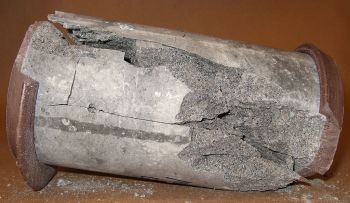Material Properties: Difference between revisions
No edit summary |
No edit summary |
||
| Line 15: | Line 15: | ||
As a result of the large costs associated with constructing and maintaining a dam, dams often have long design lives upwards of 100 years (the average age of dams in the United States is 60 years old).<ref name="NID_USACE">National Inventory of Dams (USACE), 2022</ref> Additionally, many components of a dam are completely inundated for a large portion of their design lives and are often difficult or even impossible to inspect and/or replace while the dam is in [[operation]]. As a result, the materials used to construct the dam must be able to maintain their strength and resist degradation through weathering and corrosion. Additionally, the high risks associated with a failure of many high-hazard potential dams result in the need for thorough testing, analysis, and quality control of both production and installation of the proposed materials, which are all essential to the safety and longevity of the dam as a whole structure. Materials used in the [[construction]] of dams include "earth, rock, tailings from mining or milling, concrete, masonry, steel, timber, miscellaneous materials (such as plastic or rubber) and any combination of these materials."<ref name="ASDSO">ASDSO, 2022</ref> | As a result of the large costs associated with constructing and maintaining a dam, dams often have long design lives upwards of 100 years (the average age of dams in the United States is 60 years old).<ref name="NID_USACE">National Inventory of Dams (USACE), 2022</ref> Additionally, many components of a dam are completely inundated for a large portion of their design lives and are often difficult or even impossible to inspect and/or replace while the dam is in [[operation]]. As a result, the materials used to construct the dam must be able to maintain their strength and resist degradation through weathering and corrosion. Additionally, the high risks associated with a failure of many high-hazard potential dams result in the need for thorough testing, analysis, and quality control of both production and installation of the proposed materials, which are all essential to the safety and longevity of the dam as a whole structure. Materials used in the [[construction]] of dams include "earth, rock, tailings from mining or milling, concrete, masonry, steel, timber, miscellaneous materials (such as plastic or rubber) and any combination of these materials."<ref name="ASDSO">ASDSO, 2022</ref> | ||
== | ==<noautolinks>Trainings</noautolinks>== | ||
{{Video Icon}} [[On-Demand Webinar: Dam Construction Quality Control: Dos, Dont's and Lessons Learned]] | {{Video Icon}} [[On-Demand Webinar: Dam Construction Quality Control: Dos, Dont's and Lessons Learned]] | ||
{{Video Icon}} [[On-Demand Webinar: Quality Assurance and Field Inspection for Dam Construction Projects]] | {{Video Icon}} [[On-Demand Webinar: Quality Assurance and Field Inspection for Dam Construction Projects]] | ||
Revision as of 16:59, 14 December 2022

|
| Failed Concrete Cylinder |
As a result of the large costs associated with constructing and maintaining a dam, dams often have long design lives upwards of 100 years (the average age of dams in the United States is 60 years old).[1] Additionally, many components of a dam are completely inundated for a large portion of their design lives and are often difficult or even impossible to inspect and/or replace while the dam is in operation. As a result, the materials used to construct the dam must be able to maintain their strength and resist degradation through weathering and corrosion. Additionally, the high risks associated with a failure of many high-hazard potential dams result in the need for thorough testing, analysis, and quality control of both production and installation of the proposed materials, which are all essential to the safety and longevity of the dam as a whole structure. Materials used in the construction of dams include "earth, rock, tailings from mining or milling, concrete, masonry, steel, timber, miscellaneous materials (such as plastic or rubber) and any combination of these materials."[2]
Trainings
![]() On-Demand Webinar: Dam Construction Quality Control: Dos, Dont's and Lessons Learned
On-Demand Webinar: Dam Construction Quality Control: Dos, Dont's and Lessons Learned
![]() On-Demand Webinar: Quality Assurance and Field Inspection for Dam Construction Projects
On-Demand Webinar: Quality Assurance and Field Inspection for Dam Construction Projects
![]() On-Demand Webinar: Pitfalls in Quality Control Processes for Compacted Earth Fill
On-Demand Webinar: Pitfalls in Quality Control Processes for Compacted Earth Fill
Citations:
Revision ID: 5672
Revision Date: 12/14/2022
